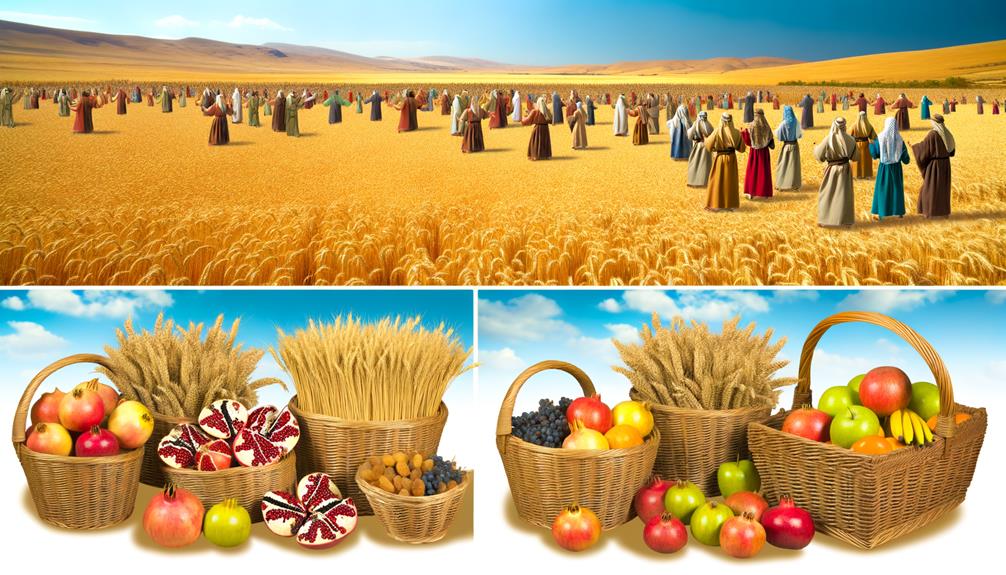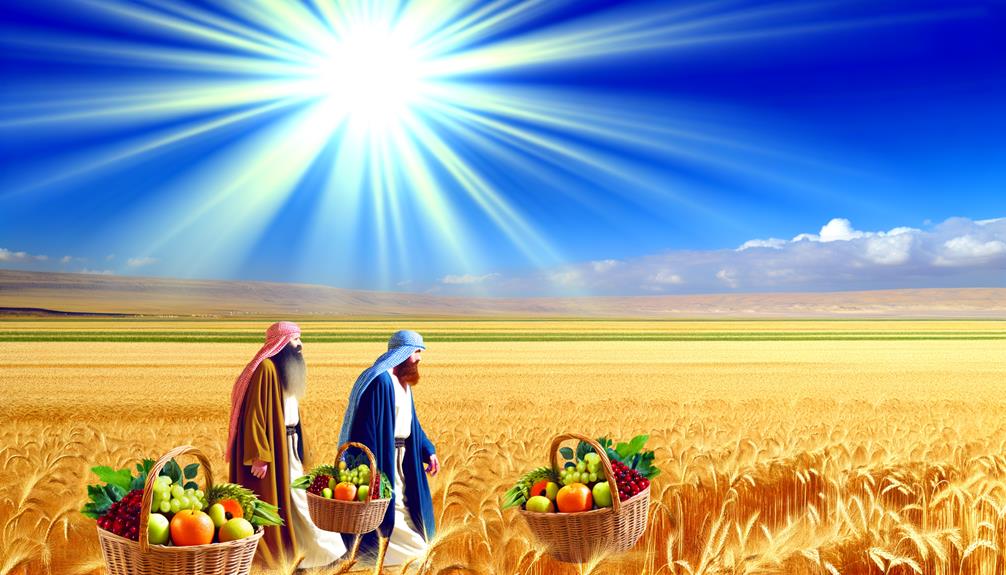Harvest In The Bible Meaning: Blessing and Judgment
In the Bible, the concept of the harvest is rich with symbolic meaning, encompassing themes of divine provision, spiritual abundance, judgment, and redemption. Old Covenant harvest festivals such as Passover, Shavuot, and Sukkot celebrated God’s material and spiritual sustenance.
Jesus’ parables, like the Parable of the Sower and the Wheat and Tares, use harvest imagery to convey spiritual truths about faith, growth, and divine judgment. Additionally, prophetic literature often depicts harvest as a time of accountability and renewal.
Biblical laws on agriculture promote social justice and community care, linking spiritual principles to daily practices. This multifaceted symbol continues to offer profound insights.

Harvest Meaning in the Bible: Symbol of Blessing, Judgment, and Spiritual Reaping
| Aspect | Biblical Insight |
|---|---|
| Definition | The gathering of crops; spiritually signifies the result of one’s labor or faith |
| Old Testament Reference | Leviticus 23:10 – “Bring to the priest a sheaf of the first grain of your harvest” |
| New Testament Reference | Matthew 9:37 – “The harvest is plentiful but the workers are few” |
| Symbolism | Blessing, judgment, spiritual reward, and divine timing |
| Spiritual Application | Urges believers to sow righteousness and be ready for God’s spiritual harvest |
Old Testament Harvest Festivals

The Old Scripture harvest festivals, deeply embedded in the agricultural cycles of ancient Israel, served not only as communal celebrations but also as significant religious observances reflecting the covenantal relationship between the Israelites and Yahweh.
Three major festivals—Passover (Pesach), the Feast of Weeks (Shavuot), and the Feast of Tabernacles (Sukkot)—marked the agricultural calendar.
Passover celebrated the barley harvest and liberation from Egypt, Shavuot commemorated the wheat harvest and the giving of the Torah, while Sukkot signified the final ingathering of crops and God’s provision during the wilderness journey.
These festivals underscored themes of gratitude, divine provision, and communal identity, weaving religious significance with agrarian life, thereby reinforcing the Israelites’ dependence on and devotion to their deity.
Harvest as God’s Provision

The concept of harvest in biblical texts frequently underscores God’s promise of divine abundance, serving as both literal and metaphorical sustenance for His followers.
This provision reflects not only material prosperity but also spiritual nourishment, indicating that faithfulness to God’s commandments yields manifold blessings.
Such themes reinforce the theological assertion that prosperity is inherently linked to spiritual fidelity and divine favor.
Divine Abundance Promised
Scriptural narratives often depict the harvest as a divine symbol of God’s provision and abundant blessings to His people.
This thematic element is prominently illustrated in passages such as Deuteronomy 28:12, where the Lord promises to ‘open to you His good treasure, the heavens, to give the rain to your land in its season and to bless all the work of your hand.’
Here, the harvest signifies not merely physical sustenance but also a covenantal assurance of prosperity and divine favor. It serves as a tangible representation of God’s faithfulness and generosity, reinforcing the theological concept that adherence to divine commandments results in material and spiritual abundance.
Consequently, the harvest becomes a profound witness to divine abundance promised to the faithful.
Spiritual Nourishment Symbolized
Harvest imagery in biblical texts extends beyond physical sustenance to embody spiritual nourishment and divine provision. This symbolism is evident in various passages, illustrating the multifaceted nature of God’s care for humanity. The harvest serves as a metaphor for God’s spiritual gifts, emphasizing His omnipresent provision and unwavering support.
Key aspects include:
- Spiritual Growth: The harvest signifies the cultivation of moral and spiritual virtues.
- Divine Wisdom: It represents the acquisition of divine knowledge and understanding.
- Community Strength: Harvest imagery underscores the importance of unity and collective spiritual well-being.
- Eternal Life: The ultimate harvest points to salvation and eternal life, reflecting God’s ultimate provision.
These elements collectively highlight the depth of spiritual nourishment symbolized by the harvest in biblical contexts.
Faithfulness Yields Prosperity
Building upon the spiritual nourishment symbolized by the harvest, the concept of faithfulness as a precursor to divine provision underscores the biblical principle that steadfast devotion to God’s commandments yields both spiritual and material prosperity.
Scriptural references, such as Proverbs 3:9-10 and Malachi 3:10, illustrate this nexus. In Proverbs, honoring God with one’s wealth leads to overflowing barns, signifying material abundance. Malachi, conversely, stresses tithing as a conduit for divine blessings, promising an outpouring of provisions.
This theological framework posits that human diligence in faith invites God’s favor, manifesting through tangible and intangible gains. The harvest, consequently, becomes a metaphor for the rewards of unwavering faithfulness, reinforcing the cyclical relationship between divine obedience and divine provision.
Symbolism in the Prophets

In the prophetic literature of the Bible, the concept of harvest frequently serves as a potent symbol for divine judgment and accountability, reflecting the moral and spiritual state of the people.
Additionally, it encapsulates themes of restoration and hope, signifying God’s promise of renewal and blessing following periods of repentance.
The metaphor of harvest further underscores spiritual renewal, inviting a deeper reflection on the transformative power of divine intervention in human affairs.
Judgment and Accountability
Within the prophetic literature of the Bible, the concept of harvest frequently serves as a potent metaphor for divine judgment and the accountability of nations and individuals. This metaphor encapsulates the inevitability and thoroughness of God’s judgment.
The prophets utilize harvest imagery to underscore several key points:
- Inevitability: Just as harvest time is unavoidable, so is divine judgment.
- Righteousness: The moral and spiritual state of individuals and nations determines the nature of their ‘harvest’.
- Divine Timing: God’s judgment occurs at the appointed time, reflecting His sovereign control.
- Consequences: The outcomes of judgment are proportionate to the actions and choices made.
This conceptual framework urges readers to understand the gravity of divine accountability.
Restoration and Hope
The prophetic literature of the Bible frequently employs harvest imagery not only to signify judgment but also to symbolize restoration and the rekindling of hope for a future marked by divine favor.
Prophets like Isaiah and Jeremiah present visions where the desolate fields of Israel and Judah are brought back to life, symbolizing the renewal of God’s covenant with His people.
This transformation from barrenness to abundance serves as a powerful metaphor for national and spiritual revival.
In Joel, the promise that ‘the threshing floors shall be full of grain’ (Joel 2:24) illustrates the hope for a restored community.
Consequently, the harvest becomes a dual symbol, intertwining themes of divine justice and the promise of redemption and abundance.
Spiritual Renewal
Prophetic texts frequently employ the imagery of harvest to symbolize spiritual renewal, reflecting the transformative power of divine intervention in the lives of the faithful. This metaphor serves as a conduit for understanding several key aspects:
- Repentance: The harvest signifies the turning away from sin and the return to righteous living.
- Restoration: It symbolizes the re-establishment of a covenantal relationship with God.
- Abundance: The plentiful harvest mirrors the richness of spiritual blessings bestowed upon the faithful.
- Judgment: It also underscores the eventual divine judgment, separating the righteous from the wicked.
Jesus’ Parables on Harvest

In examining Jesus’ parables on harvest, one observes a profound use of agricultural metaphors to convey spiritual truths about the Kingdom of God.
The Parable of the Sower (Matthew 13:3-9) illustrates different responses to the gospel message, likening them to varying types of soil.
Similarly, the Parable of the Wheat and the Tares (Matthew 13:24-30) juxtaposes the righteous and the wicked, emphasizing divine judgment at the end of the age.
These parables employ familiar agrarian imagery to elucidate complex theological themes, making them accessible to a first-century agrarian audience.
Spiritual Harvest and Salvation

How does the concept of spiritual harvest in biblical scripture illuminate the process of salvation and the believer’s role in it? The metaphor of harvest in scripture often symbolizes the culmination of God’s redemptive work and the gathering of souls into His kingdom.
The process of salvation, likened to harvesting, underscores the active role believers play in God’s plan. Key elements include:
- Sowing the Seed: Believers are called to share the gospel, planting seeds of faith.
- Nurturing Growth: Discipleship and teaching help new believers grow spiritually.
- Reaping the Harvest: Evangelism efforts lead to the conversion and salvation of souls.
- Celebrating the Yield: The ultimate joy and fulfillment in witnessing the expansion of God’s kingdom.
This spiritual harvest reflects divine grace and human collaboration.
Harvest in Christian Teachings

Within Christian teachings, the concept of harvest serves as a profound metaphor for spiritual growth, evangelistic efforts, and the fulfillment of God’s redemptive plan.
The harvest imagery underscores the importance of discipleship and the nurturing of faith, often likened to sowing and reaping. Parables such as the Sower (Matthew 13:1-23) elucidate how the Word of God, when planted in receptive hearts, yields abundant spiritual fruit.
Additionally, Jesus’ directive to His disciples to ‘pray earnestly to the Lord of the harvest’ (Matthew 9:38) emphasizes the urgency of evangelism.
This theological framework positions believers as laborers in God’s field, tasked with cultivating and gathering souls, hence advancing the Kingdom of God and actualizing divine purposes on Earth.
Judgement and the End Times

The metaphor of harvest extends beyond spiritual growth and evangelism to encompass themes of judgement and the culmination of history as depicted in eschatological narratives.
In biblical literature, the harvest signifies the final gathering of souls, reflecting divine judgement and the ultimate fulfillment of God’s plan. Key aspects include:
- Separation of the righteous from the wicked: As seen in Matthew 13:30, where wheat is separated from tares.
- Reaping of consequences: Galatians 6:7 underscores that a person reaps what they sow.
- Final judgement: Revelation 14:14-16 portrays the Son of Man reaping the earth.
- Eternal destiny: The harvest metaphor illustrates the eternal destinies of individuals, as depicted in Matthew 25:31-46.
This imagery underscores the gravity of moral and spiritual accountability.
Agricultural Practices and Laws

Biblical agricultural practices and laws not only regulated Israelite farming activities but also embedded theological principles that reinforced communal responsibility and divine providence.
The laws delineated in Leviticus and Deuteronomy, such as the Sabbatical year (Leviticus 25:1-7) and the Year of Jubilee (Leviticus 25:8-55), mandated rest for the land and debt forgiveness, underscoring divine ownership of the earth.
Regulations on gleaning (Leviticus 19:9-10; Deuteronomy 24:19-21) required farmers to leave portions of their crops for the poor and the foreigner, emphasizing social justice and community solidarity.
These practices not only guaranteed sustainable agriculture but also fostered a sense of divine stewardship and a commitment to equitable resource distribution within the covenant community.
Modern Interpretations of Harvest

Building upon the theological and ethical foundations laid by biblical agricultural laws, modern interpretations of harvest often explore its symbolic and spiritual dimensions in contemporary religious thought and practice.
These interpretations typically emphasize:
- Spiritual Renewal: Harvest as a metaphor for spiritual growth and renewal, reflecting personal and communal transformation.
- Ethical Stewardship: Emphasizing responsible care for creation, aligning with eco-theological perspectives.
- Social Justice: Viewing harvest as a call to address inequities, ensuring fair distribution and support for the marginalized.
- Eschatological Hope: Interpreting harvest as a symbol of ultimate redemption and the fulfillment of divine promises.
These facets illustrate how the ancient concept of harvest continues to resonate, offering rich avenues for reflection and action in modern faith contexts.
Conclusion
The concept of harvest in the Bible transcends mere agricultural practices, embodying divine provision, spiritual salvation, and eschatological judgment.
The multifaceted symbolism found within Old Covenant festivals, prophetic literature, and Jesus’ parables elucidates a profound theological narrative.
Contemporary Christian teachings continue to reinterpret these ancient themes, emphasizing an eternal reaping of moral and spiritual outcomes.
Hence, the biblical harvest serves as a perennial reminder of the cyclical interplay between sowing and reaping, both temporally and spiritually.






